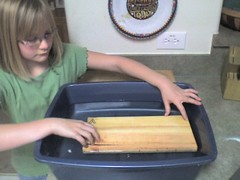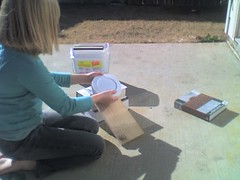What follows is her introduction and conclusion, interspersed with pictures of her procedure:

"My project is on friction. Friction is a force that slows things down or stops them altogether. Sometimes friction is good, and sometimes friction is bad. My mom and I once saw a video of cars slipping and sliding on the icy roads. The lack of friction on the road was caused by the ice. There were car accidents. One man could not control his car and rammed into the city truck that was trying to help. More friction would have made things better.

"But more friction is not always desirable. For instance, in order to ice skate, I want less friction so I can glide on the ice. In the book, Hans Brinker and the Silver Skates, Hans and his sister only had wood skates that Hans had carved for them. But the skates made them trip. Their skates provided too much friction.

"I decided to study friction because it was a new idea for me. I wanted to find out what had friction, and what did not. I decided to use two boards to make two different kinds of ramps: a dry ramp and an icy ramp. My hypothesis was that the icy board would have less friction than the dry board.

"In my project I learned that icy things do not have a lot of friction. This helps me understand more about ice skating. In ice skating, I cannot have friction or else I will not be able to skate fast. If I have friction I will stop suddenly and fall and that will hurt. In Hans Brinker, when Hans and his sister got metal skates, those skates did not have as much friction as their wood skates and it helped them skate a lot more smoothly. And I also understand more about the dangers of ice on the roads. If the roads are icy, the lack of friction will make the car slip and turn, and my mom will not be able to control the car. We could cause a car accident unless we stay home."
No comments:
Post a Comment